How To Create Personalized Emails That Engage And Convert
If most of your subscribers constantly ignore your emails, or mark them as spam, or even delete them without opening, then it’s time to change your strategy.
Let’s face it; everyone’s inbox is not only full, but overflowing.
Want your prospects, subscribers, customers and other target readers to eagerly click, read and engage with your email, once it arrives in their inbox?
Then you need to create personalized emails.
In this detailed guide, you’ll learn:
- What exactly are personalized emails?
- 5 important steps to take before writing personalized emails
- 12 actionable tips for creating personalized emails that boosts your email marketing effort and deliver excellent results for your business
Ready? Then, let’s start.
What are personalized emails?
Unlike generic emails blasted out to your entire list, personalized emails are created for a specific group of people, or a segment of your list, based on information and data you have about them.
Information like their names, gender, purchase history, geographical location, browser history, and so on.
Though meant for a group or a segment, personalized emails are written with one person in mind.
You simply imagine you’re writing to one person, who’s a friend, and write to that person only.
This way, it helps you develop a strong connection with your readers.
In addition, it goes further to convince them that:
- You know each reader as an individual
- You care about their individual interests, needs and wants
- You want to provide information they’re searching for
- You’re ready to help them solve their problems
Without personalization, your email will likely appear salesy or pushy.
But when personalized, it becomes relevant and more valuable to your readers, giving them a strong incentive to click and read.
Here are some amazing statistics about personalized emails:
- Segmented emails perform much better than non-segmented emails, with 100.95% higher click rates, 31% higher open rates and 9.37% lower unsubscribe rates.
- 80% of consumers are more likely to buy from a company that provides a tailored experience.
- Personalized emails were found to produce 6 times higher revenue and transaction rates than emails not personalized, with 29% higher open rates and 41% higher click rates, as far back as 2013.
- Marketers that segmented their email lists as far back as 2015 had 28% lower unsubscribe rates and 39% higher open rates
- By 2016, personalization helped to achieve 158% increase in click rate.
- 52% of consumers are ready to stop buying from a company that doesn’t personalize it’s messages.
Check out what businesses think of personalized emails:
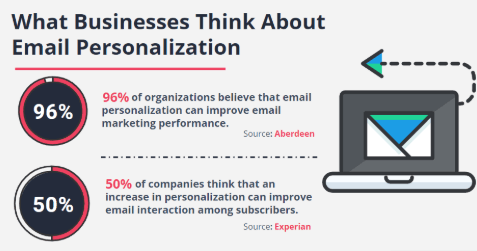
Now that you have a better understanding of personalized emails and its mouthwatering benefits, don’t waste that knowledge.
Make good use of it in your email marketing so your business can reap some of those outstanding benefits.
Before we look at how to create personalized emails, there are a few steps to take first.
Before you write, take these five steps
- Define your goal
- Segment your email list
- Choose the segment you want to write to
- Get to know your subscribers in that segment
- Come up with an irresistible offer
Let’s take a closer look at each step so you can understand why they’re essential.
1. Define your goal
Since you’re putting a lot of time, energy and resources into email marketing, you likely want to achieve something specific in your business.
That is your goal.
Whether short or long-term, it’s okay if your goal cannot be achieved with a single email.
Here are a few examples of possible goals you may have:
- Creating awareness for your website and business
- Increasing sales
- Getting more referrals
- Increasing engagement to build loyalty.
Having a goal for your email marketing in general, and for each email you write, will keep you focused and on track.
And also help you determine whether your goal was achieved or not, at the end of the day.
2. Segment your entire email list
Look at everyone on your email list and you’ll likely find a combination of:
- Male and female
- The young, the middle aged and the old
- People living in different geographical locations across the globe
- People that have purchased from you
- People that are yet to purchase anything
Because they’re different, you can expect them to have different interests, needs, wants and challenges.
And this is where segmentation comes in.
Segmentation helps to divide your entire email list into smaller groups or segments, using a variety of factors or ideas.
You can even use up to 30 ideas to segment your email list such as:
- Age
- Geographical location
- Gender
- Interest level
- Content topic
- Past purchases
3. Choose the segment you want to write to
With your entire list broken up into smaller groups and segments, you should choose one segment to write to, at a time.
When you do this, you’ll be able to identify your readers and get to know them better.
Making it easier to provide value, when you write to them.
4. Get to know your readers in that segment
Without a thorough knowledge of your readers in the segment you’re writing to, it may be difficult to come up with relevant content that will be of value to them.
To know your readers better, go out of your way to learn:
- Their interests, needs and wants
- Why they signed up to receive your email in the first place
- Issues they’re struggling with
- Information they need but don’t have
Some effective ways to learn more about your readers are:
- Conduct a survey
- Encourage them to reply to your email
- Ask relevant questions
- Do your research
- Create a persona
- Give them options to choose from
When you know your readers and understand what makes them tick, identifying the right type of valuable content for their specific need becomes easier.
5. Come up with an irresistible offer
To encourage your readers to click, read and engage with your email, have a juicy and relevant offer for them that:
- Answer questions they’ve been asking
- Meet their needs and wants
- Provide a solution to their problems
- Attract and hold their interest
- Provide information they’ve been looking for
Examples of such offers include:
- A link to your latest blog post or guide
- A new eBook
- A discounted offer of your new product
- A free webinar
When you dangle such personalized valuable offers in front of your readers, it can attract their interest and entice them to click and read your emails.
It can also go further to convince them to take any action you want them to take.
Actionable tips for writing engaging personalized emails
You’ve defined your goal, segmented your email list and identified the segment you’re writing to.
You’ve also learnt a lot about your target audience and have found a juicy and relevant offer for them.
At this point, you have all you need to write personalized emails.
Without wasting time, use these 12 actionable tips to create personalized emails that engages and convert.
1. Create a click-worthy subject line that grabs attention
Your email subject line is one of the first things your reader sees in their inbox and it has a strong influence on whether your email is opened or not.
From Invesp, we have that 47% of email recipients open email based on the subject line alone while 69% report email as spam, also based on the subject line alone.
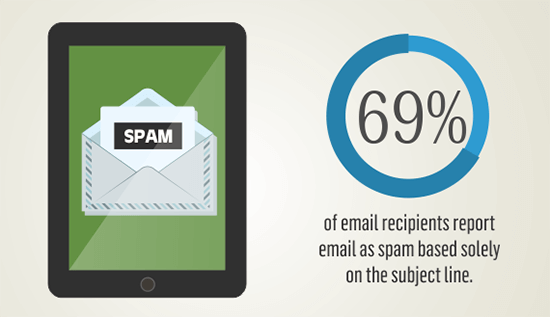
In addition, subject lines with recipient names were found to have higher open rates at 18.3% compared to 15.7% for those without names.
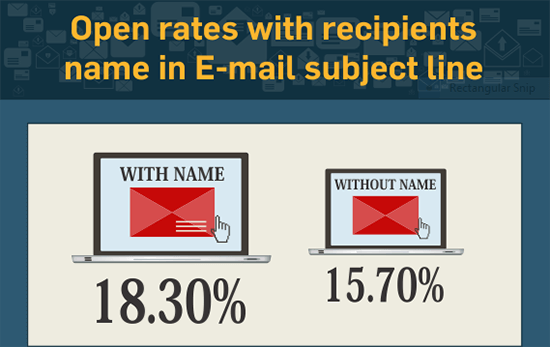
Findings from another study also showed that personalized email subject lines increase email open rates by as much as 50%.
Tips to write attention grabbing subject lines that readers click and read:
- Ask a question
- Use a subject line that pique curiosity
- Add the name of the recipient, if possible
- Don’t go overboard with CAPS
- Keep it short and to the point
- Use power words
- Avoid using lots of exclamation marks
- Remember to optimize your subject line for mobile
- Ensure your subject line matches your email content
To get your target readers clicking and opening your emails, take your time and create a personalized subject line that provides value, sparks interest and grabs attention.
2. Ensure your name and brand is visible in the “from” box
In addition to the subject line, another key area noticed once your email arrives is the sender.
Whether you’re using a personal name or company name or both, a lot of people use this as a yardstick to decide whether to open your email or not.
In a test carried out by Hubspot, they discovered that emails with a personal name as the sender have a higher chance of being opened compared to emails with a company name as the sender.
By using a person’s name in addition to your brand name, your recipient can quickly identify where the email is coming from.
Here is an example of how Hubspot and ConvertKit does that:

Note: On the subject of ConvertKit, if you’re looking for a simple email marketing platform designed for content creators, it’s well worth checking out. Check out this review and tutorial of ConvertKit at Blogging Wizard.
3. Use preview text area optimally
Apart from your email subject line and the sender’s name, another important area that’s noticed before your email is opened is the preview text area.
Look at the subject line of an email in your inbox and you’ll notice that some words appear to the right of the subject line as shown below:

Those words are the preview text, sometimes referred to as the preheader text and they give your recipient a very short preview of the content of the email.
Because it’s very close to the subject line, most people read it along with the subject line.
So, it also influences the decision to either open the email or not.
Always support your attention-grabbing subject line with a short and engaging preview text, to further convince your readers to click and read your emails.
4. Open with a friendly greeting, using the reader’s name
Once your email is opened, your greeting is the next thing your recipient will notice.
Remember you’re supposed to write as if you’re writing to a friend.
So, use a simple, casual and friendly greeting and add the recipient’s name.
Take a look at a few examples you can use, according to Hubspot:
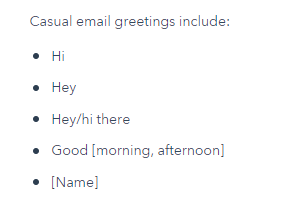
While it’s okay to use the recipient name more than once in the email, don’t overdo it.
Make sure also that you get the name and spelling right.
This helps you start off on the right foot and can keep your recipient reading from beginning to the end.
5. Clearly spell out your irresistible offer
After your greeting, state your relevant and juicy offer clearly, without rambling or beating around the bush.
That’s the same irresistible offer you identified earlier, before you started writing.
Since this offer is personalized, highlight all the relevant benefits your recipient can look forward to, such as how the offer will:
- Provide a solution to a specific problem
- Address a specific need
- Provide a particular information
- Fulfill a certain desire or yearning.
By doing this, you’ll increase your chances of getting your readers to engage fully with your email.
6. Include a very strong CTA
Do you have an action you want your readers to take, after reading your email?
Your call to action (CTA) should be a persuasive instruction or invitation that urges your reader to take an action and can be placed strategically within the content of your email.
It can be in form of a button or a link but buttons are known to perform much better with 28% increase in click-through rate compared to a link.
Check out these examples from Campaign Monitor:
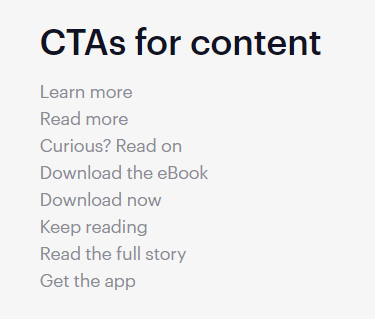
Having more than one CTA in your email can overwhelm your readers or confuse them or both, so limit yourself to one CTA per email.
Research also shows that emails with a single call to action can increase clicks by 371% and sales by a whopping 1617%.
Use these tips to create a strong CTA that readers click:
- Use action-oriented verbs
- Write in first-person e.g. Reserve my seat, etc
- Use a brightly colored button as your CTA
- Avoid using generic words like submit, click, and so on
- Let your CTA text be big enough to draw attention but not too big
- Create a sense of urgency by using words like “Now” or “Today only” and so on
- Limit the words to 2 to 3 or at most 5 or 6
To encourage your readers to take action, add a persuasive and eye-catching CTA in your personalized emails.
7. Adopt a casual and conversational tone
Since you’re supposed to be writing to a friend, using a casual and conversational tone is your best bet.
Not only will you appear more human and real to your readers, it can also make them feel as if you are sitting down together, chatting over coffee.
And can inspire them to read every part of your email.
But to make this happen, feel free to break some grammar rules.
How to write in a conversational manner:
- Use simple, easy to understand, everyday words and grammar that your reader is familiar with
- Start your sentences with “Because,” “Or,” “And,” or “But”
- Use the word “you” often to connect better with your reader
- Avoid passive voice and use active voice
- Use interjections like “ouch,” “phew,” to add emotions
- Remember to ask relevant questions
- Use contractions like “we’ll,” they’re,” and “she’s”
- Edit your writing so that it appears more conversational
Bottomline, using a casual and conversational tone can improve the personalization of your email, persuade your readers to read every single word and also take desired action.
8. Use a scannable format
Have you heard that only 16% of online readers read line by line while a huge 79% just skim and scan by glancing through the content quickly, to pick relevant points?
To tell the truth, how people read online is different from how they read offline.
And online readers are known to be very impatient.
So, encourage your readers to engage fully with your email by making it easy to scan.
Here are a few ways to achieve that:
- Write short sentences
- Avoid writing large blocks of text so add lots of white space
- Use one sentence paragraphs
- Introduce subheadings
- Use as few words as possible to get your point across
- Add bullet points
- Use bold text and italics wisely
9. Sign off casually
Since you started your email with a casual and friendly greeting and used a casual and conversational tone all through, it makes sense to follow the same pattern with your sign off.
So, close your email by signing off in a casual and friendly manner with any of these words:
- Best
- Cheers
- Thanks
- Talk soon
By consciously using the same tone throughout the email, you’ll create a good reading experience for your target audience and keep them engaged.
10. Use a signature with a person’s name and picture
Using a person’s name and picture in your email signature is a solid way to remind your readers that you’re a real human being.
It adds a personal touch and goes a long way to boost your credibility.
With your name and picture in your signature, you’ll appear friendlier and more approachable.
And also encourage your readers to engage better with your emails.
11. Proofread again and again
Having worked so hard, don’t spoil everything by allowing typos, bad grammar and wrong spelling to be seen in the email.
These errors can annoy your readers and make them lose interest in reading further.
In addition, they can destroy your credibility and convince your readers to ignore all your emails henceforth.
To avoid all these, proofread your email more than once, before you send it out.
For your proofreading to be effective, take a break once you finish your draft and come back to it later, with fresh eyes.
This can help you pick out all those errors you didn’t notice before.
Ensure your email is free from typos, bad grammar and misspellings to keep your target audience hooked and engaged to the last word.
12. Use an email address that allow replies
The whole point of writing personalized emails is to connect better with your readers so they trust you enough to always open, read and engage with your emails, every time.
This type of connection becomes impossible when it’s done as a one-way communication.
And that’s why an email address that doesn’t allow replies is a bad idea.
It defeats the whole purpose of writing personalized emails and suggests a response or feedback from your target audience is not important.
But with an email address that allows replies, you’re opening a wide open door that allows and encourages your readers to respond to your email, at their convenience.
This takes personalization to a higher level and further raises your chances of getting your readers to take the action you desire.
Increase sales with personalized emails
Writing emails that engage and convert is not a big mystery.
Once you can identify your target readers, study and learn everything about them.
Armed with all you’ve learnt, come up with a relevant and valuable offer that meet their needs and use this to personalize your emails to them.
Because of the value you’re providing, they’ll be ready to open and read your emails and also take actions you want them to take.
Always optimize your email for mobile because as at June 2018, mobile email opens remain the most popular.
When done right, writing personalized emails can help you achieve fantastic results in your email marketing.
And keep you smiling to the bank.
